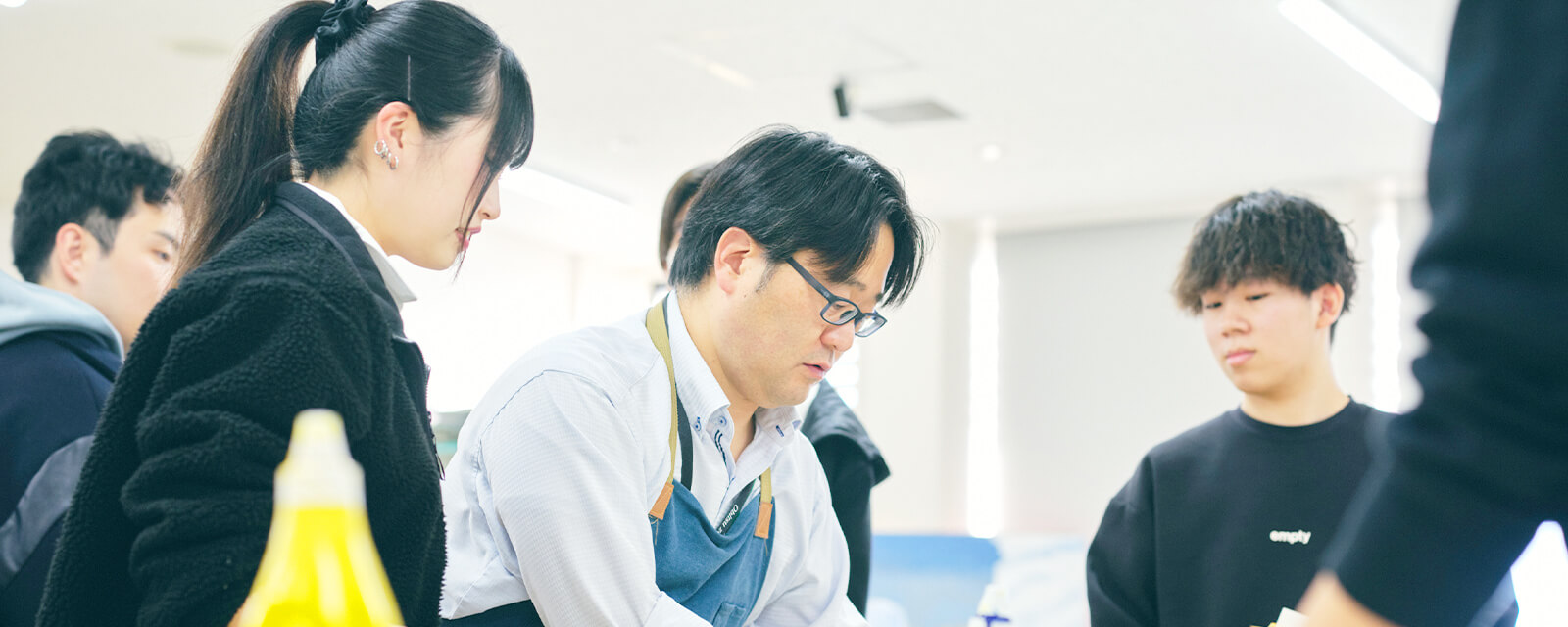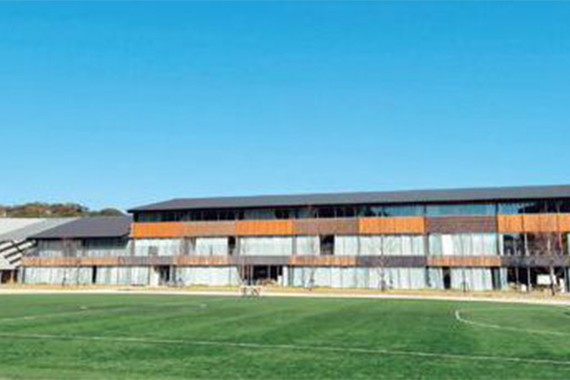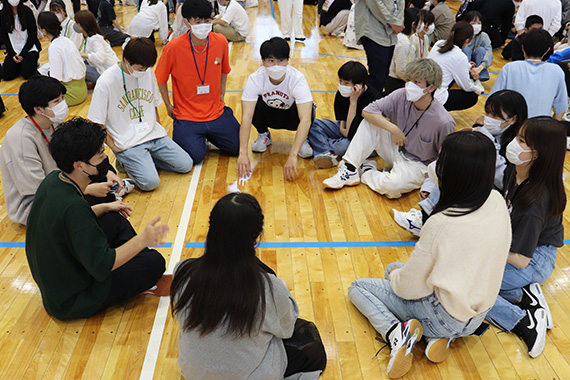
- 八王子キャンパス
教育学部 初等教育学科 初等教育コース

- 八王子キャンパス

現代的な課題に対応した教育のあり方を学び、
教育の現場を担う人材を育成
現在の教育に求められていることは何でしょうか。初等教育コースでは、教員免許をはじめとする資格取得のための基礎的な学びを進めながら、現代的な教育課題に対応した教育のあり方や方法について、提携校で子どもたちと触れ合いながら理論的・実践的に修得。専門的知識と技能を備え、教育の現場を担う人材を育成します。

小学校の観察実習
帝京大学小学校を訪問して実施される観察実習では、子どもの学びの姿を自分の目で見て教員になるための資質や能力を培います。授業展開、授業の狙い、目標、内容、課題、評価、子どもの反応など、観察ポイントは多岐にわたります。また、この授業観察を通して学校訪問の基本的なマナーや態度も身につけます。

新入生と上級生の交流が盛んです
初等教育コースでは、5月に授業の一環として新入生全員と上級生で企画運営を行う活動があります。新入生のスムーズな大学生活を支援し、大学で学ぶ意義や教育学および教員養成、4年間の学習の流れなどについて理解を深め、学生同士または学生と教員との人間関係を深めることを目的としています。さらに同学科コース2年生の学生有志がメンター(指導学生)として参加し、1年生をサポートするほか、当日はパネルディスカッションや個々に新入生の相談に応じるなど、本学科の特徴でもある学年を越えた学生同士のつながりを継承していく一助となる活動を行っています。
スタディ・スキルの向上を目的とした演習と理論的・専門的な各科目を履修しながら、併行して帝京大学小学校での教育参加やボランティア活動など、4年間を通して子どもたちと触れあい、実践的・臨床的に学び、即戦力性を身につけます。3・4年次は主体的に演習や卒業研究に取り組み、学びの総仕上げを行います。教育実習も3年次からスタートします。
教科指導法(家庭)
本授業では、小学校家庭科の指導法について学びます。家庭科概論で学んだ学習指導要領についての知見をもとに、学校現場の実践例から家庭科の指導法を具体的実践的に学びます。また、小グループで指導案を練り上げ、模擬授業を行って検討し合うことを通して、授業に生かせる指導力の育成を図ります。さらに、他教科の領域や食育との関連を見通したカリキュラムづくりや、家庭科における言語活動の工夫、安心・安全な教科経営のためのリスク(クライシス)マネージメントについても学びます。
教科指導法(算数)
本授業では、小学校学習指導要領に示される算数科の目標達成をめざし、授業設計能力や授業力を向上させ、同時に教員としての資質を高めることを目的としています。算数的活動を重視した問題解決的な学習の展開や、算数への関心・意欲・態度、数学的な考え方、数量や図形についての技能、知識・理解という4つの観点からバランスの良い指導計画を作成することに重点が置かれます。授業内で目標と評価規準および評価方法を明確にし、指導と評価の一体化を図ることも学びます。また学力の3要素の育成につながるICT(情報通信技術)機器活用のあり方や、特別支援を必要とする児童に配慮し、困りを生じさせない支援のあり方なども考えていきます。模擬授業ではすべての学生が指導者役、児童役をこなしながら授業記録を作成。授業を主観的・客観的に評価し、授業観を深めます。
教科指導法(理科)
小学校理科の目標は「自然に親しみ・・・」からはじまります。本授業でも学生が、自然に働きかける体験を重視した学びに力を入れています。八王子キャンパスには、設備の充実した理科実験室があり、実際の小学校の理科室を想定した模擬授業が行えます。どの模擬授業でも工夫した教材を使ったり、情報を活用したりして、学生が児童の立場になって観察・実験に取り組み、本学の教育指針のひとつ「実学」としての学びとなっています。また本授業を通して、理科指導の根幹をなす問題解決の流れに沿った授業展開のあり方が学べるように授業を進めています。
ライフデザイン演習
1年生を対象としたこの科目は、本学の教育理念に基づき「社会力」「自己教育力」「専門力」の基礎力を育成することを目的として実施されています。具体的には以下のようになります。
知的障害者教育概論
特別支援学校教員免許状の取得をめざす学生や特別支援教育に関心を持つ学生に対する入門授業です。障害とは何か、特別支援教育とはどのような教育か、知的障害とはどのような障害か、知的障害を有する児童生徒の教育の特色は何か、領域・教科を合わせた指導(日常生活の指導、遊びの指導、生活単元学習、作業学習)などに焦点を当てて授業を展開します。特別支援学校学習指導要領と学習指導要領解説を基本テキストとしますが、特別支援学校などの各種授業ビデオ視聴や知的障害特別支援学校の見学などとともに個別の教育支援計画、教育課程、指導計画、個別の指導計画や各種の学習指導案などの資料から知的障害者教育の実際を学びます。本概論をステップとして次の「知的障害教育課程論」「知的障害者指導法」へ学修をつなげます。
初等教育論
本授業では、幼稚園、小学校のさまざまな組織・基礎理論を理解した上で、事例をもとに実践的に考察し、初等教育の本質をめぐる現状・課題とその改革点の動向について学習します。学生には現代社会における初等教育の役割、歴史的な考察、基本的な考え方、学校組織、現状などを把握しながら、初等教育の重要性・思想を国際比較視点から理解し、自分なりに主題・見方を発見してもらいます。また、ペア学習・グループ学習、全体討論や個人発表の機会を通してさまざまな考えやアイデアを交換し、問題意識を深め思考を促しています。
GPA(Grade Point Average)制度の導入の趣旨は、1. キャンパスとして統一した基準を作成すること、2. 公平性に優れた基準であること、3. 国際的に通用する基準であることとし、学修の成果をGPAという客観的な数値で評価するものです。またこの制度は、欧米の大学で採用されている成績評価制度に概ね準拠しており、海外留学、海外の大学院進学、外資系企業への就職などの際に学力を証明する指標として、海外でも通用する成績評価制度となっています。
| 区分 | 評価 | GPA | 成績評価基準 | 評価内容 | 英文内容) |
|---|---|---|---|---|---|
| 合格 | S | 4.0 | 90点以上 | 特に優れた成績を表します | Excellent |
| A | 3.0 | 80点台 | 優れた成績を表します | Good | |
| B | 2.0 | 70点台 | 妥当と認められる成績を表します | Satisfactory | |
| C | 1.0 | 60点台 | 合格と認められる最低限の成績を表します | Pass | |
| 不合格 | D | 0.0 | 60点未満 | 合格と認められる最低限の成績に達していないことを表します。また、授業等の出席日数不足および当該授業における試験の未受験等も含みます | Failure |
| 対象外 | N | - | - | 編入や留学等により他大学等で修得した科目を本学の単位として認定したことを表します(単位認定科目) | Credits Transferred |

| 科目区分 | 必修・選択の例 | 所要単数 | |||||
|---|---|---|---|---|---|---|---|
| 共 通 教 育 科 目 ※4 | 教養 教育科目 | 人文科学系分野 | 選択必修 | 2以上 | 8以上 | 30※1 | |
| 社会科学系分野 | 2以上 | ||||||
| 自然科学系分野 | 2以上 | ||||||
| 文理融合分野 | 選択 | - | |||||
| 初年次 教育科目 | ライフデザイン演習Ⅰ・Ⅱ | 必修 | 2 | ||||
| キャリア教育科目 | 選択必修 | 2 | |||||
| 情報教育科目 | 選択必修 | 2 | |||||
| 外国語 教育科目 | 現代英語Ⅰ・Ⅱ・Ⅲ・Ⅳ | 必修 | 4 | ||||
| 専門科目※4 | 必修 | 16 | 74※3 | ||||
| 選択 必修※2 | 教育学系 科目 | 10 | |||||
| 現代教育 課題系科目 | 4 | ||||||
| 選択 | 44 | ||||||
| 自由選択 | ・専門科目74単位の超過単位 ・共通教育科目30単位の超過単位 ・オープン科目の修得単位 ・副専攻プログラムの修得単位 ・他大学での認定単位 | 選択 | 20 | ||||
| 合計 | 124 | ||||||